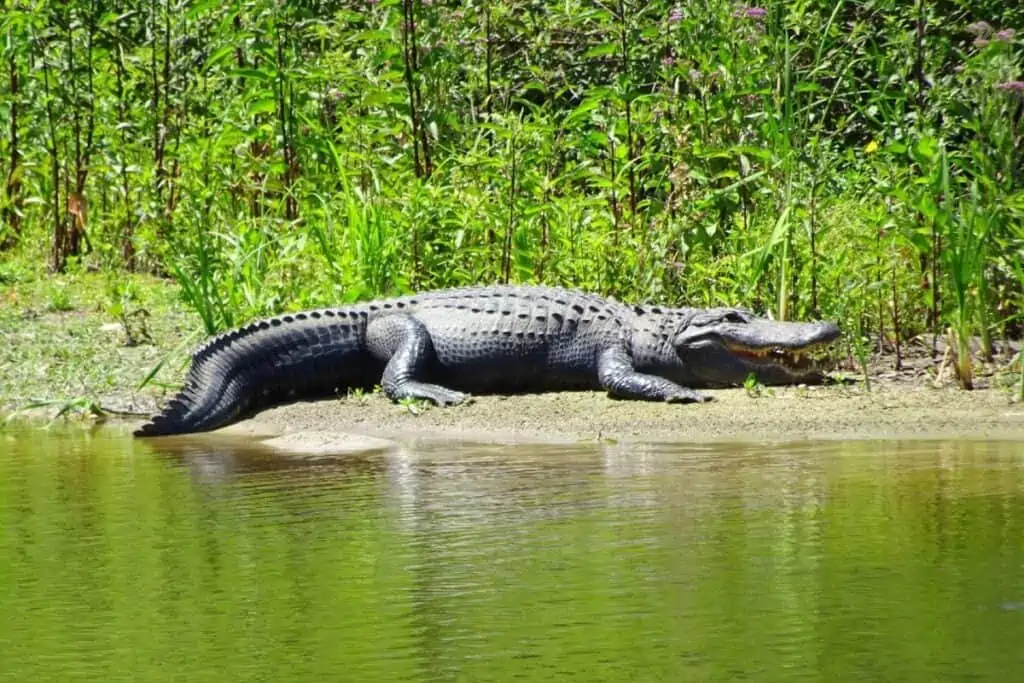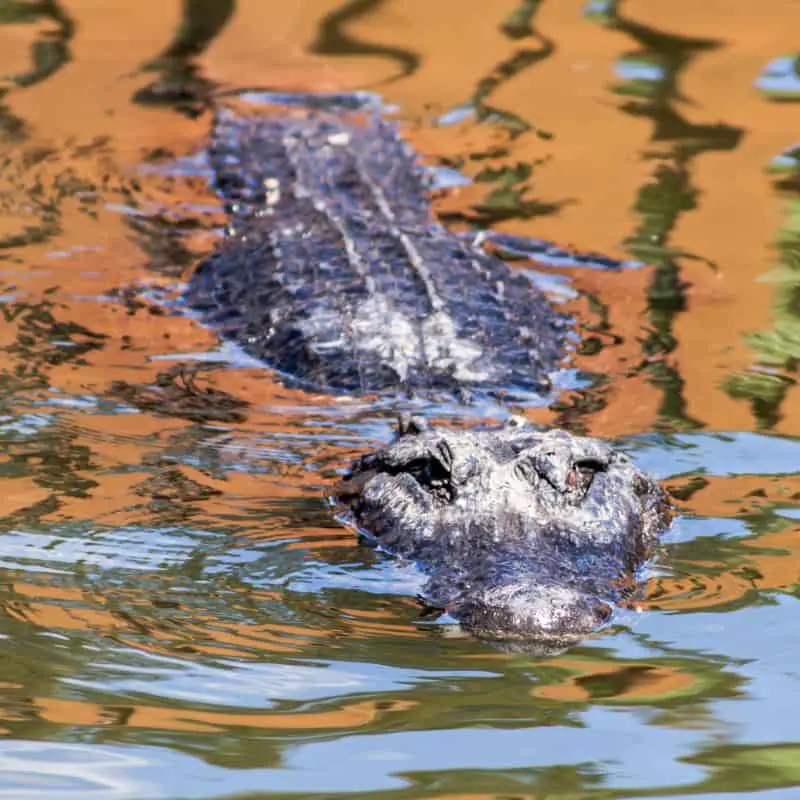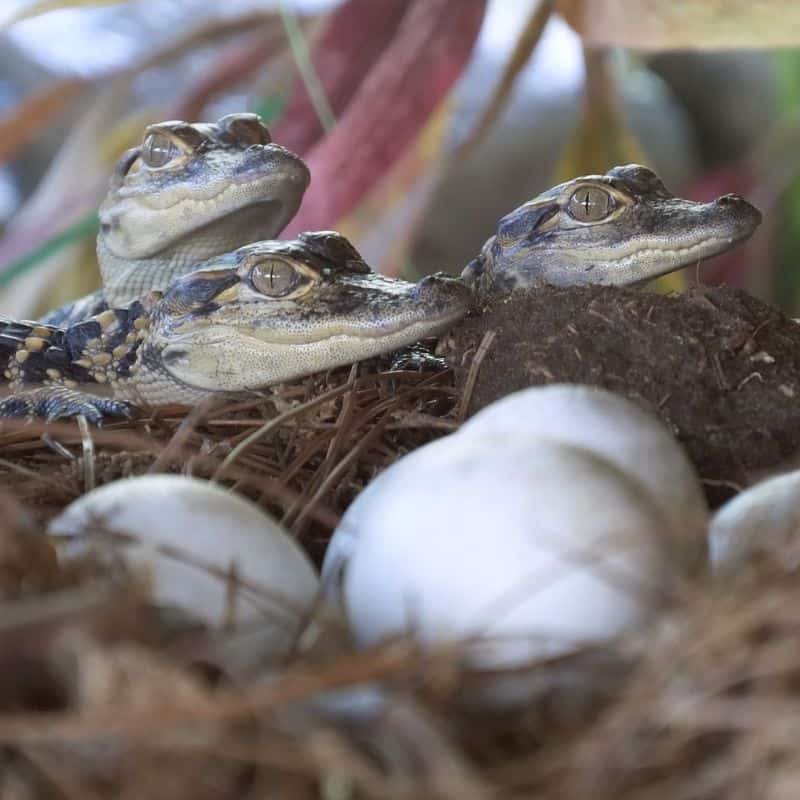American alligators are almost synonymous with the South, and when thinking about where alligators live, thoughts of bayous and the Everglades are usually the first to pop into mind. Although American alligators have a wider distribution than the “deep south,” are there alligators in Virginia?
No, generally speaking, there aren’t alligators in Virginia. American alligators have a natural distribution from Florida in the South, throughout the southeastern US, to North Carolina and as far west as central Texas. Alligators are a temperate species, and “officially,” they don’t venture into Virginia, but you might find one in rare situations.
Although you won’t find “wild alligators” in Virginia, how far north would you find them? What is the reason behind this lack of crocodilians in the Old Dominion? And what is the possibility of alligators spreading into Virginia and other states outside their current range?

Why Do Alligators Not Occur Further North than Carolina?
American alligators (Alligator mississippiensis), as their name implies, are endemic to the North American continent, particularly in the southeastern region of the United States.
Although alligators moved up and down the coastline over the last few million years, currently, alligators do not occur further north for several reasons:
Alligators Are A Temperate Species
The most significant reason for alligators not occurring north of North Carolina is that they are poorly adapted to the colder conditions further north.
While most members of the crocodilian order (alligators, caimans, crocodiles, and gharials) inhabit tropical and subtropical regions, alligators are slightly better adapted to cooler, temperate climates.
However, alligators are ectothermic (cold-blooded), which means they cannot produce heat; instead, alligators (like all reptiles) absorb heat from their environment.
This heat allows the alligator to function normally (i.e., it provides the energy required for alligators’ bodies to work).
Without this heat energy, alligators would become sluggish, struggle to digest food, and potentially die (malnutrition).
The southeastern US provides alligators with suitable summer and winter conditions, and while summer temperatures in Virginia (and higher) might be suitable, winter is too cold for alligators.
Alligator Adaptations To The Cold
During winter, alligators go into (a type of) hibernation (brumation) in the colder reaches of their range.
As winter intensifies and the water cools, their metabolism, heart rate, and breathing slow down.
This “slowing down” allows the alligators to remain inactive through winter without needing to eat or breathe that often (alligators can hold their breath for up to eight hours in icy water).
Aside from physiological adaptations, alligators burrow (called gator holes, up to 65 feet long) into river banks and swampy areas to keep warm.
In extreme cases, when the water body freezes, the alligator remains submerged, with only its nostrils protruding (to keep breathing).

Human Interventions Limit Alligator Distribution
Aside from their inclination toward warmer climates, anthropomorphic activities restrict alligator distribution.
Alligators were historically in the southern areas of Virginia, particularly in the Great Dismal Swamp.
However, during the 1900s, humans placed tremendous pressure on the Virginia alligator populations through hunting, resulting in their eradication and southward migration.
Aside from directly impacting alligator numbers through hunting, humans indirectly restrict alligator distribution through:
- Damming up rivers
- Establishing canals
- Draining wetlands for land (agriculture or development)
- Building roads and other infrastructure
Other Factors Limiting Alligator Distribution
Alligators require certain environmental conditions to survive, preventing alligators from establishing themselves when absent.
Limiting factors to alligator distribution include:
Access To Feeding And Breeding
Alligator survival depends on access to feeding and breeding grounds. Without accessible food sources, alligators would not have enough food and would starve. Alligators avoid areas devoid of food and feeding opportunities.
Likewise, alligators (like all animals) are programmed to reproduce, and if there are no mates within an area, they are unlikely to remain for an extended period.
I.e., should an alligator stray out of its range, but there are no others, it is likely to try and return for breeding opportunities.
Habitat And Terrain Constraints
Alligators require freshwater and usually don’t do well in steep/highland areas. Although they migrate up and down rivers, alligators usually prefer slower-moving waters (particularly in the middle and lower reaches).
Alligators lack the salt gland that their cousins, the crocodiles, possess. This gland assists in removing salt from the crocodiles’ bodies, allowing them to access salt water.
The absence of this gland prevents them from moving to islands (across the ocean) and inhabiting brackish waters (where fresh and saltwater mix, like estuaries).
Physical barriers like rocks, cliffs, waterfalls, and areas devoid of water prevent alligators from spreading into new regions in otherwise suitable habitats.
Climate Incompatibilities
Alligators are cold-blooded and therefore require specific climatic conditions to survive. Regions that are too cold, too hot, or don’t receive enough rainfall exclude alligators.
Aside from survival, alligators (and all reptiles) require a certain temperature for their eggs to develop (above 80°F). Temperature also affects the developing alligators’ gender. Females develop at 87.8°F and below (and again when the temperature is above 90.5°F), while males develop at around 89.6°F.
The further north you travel, the alligators have a slower growth rate and the less successful they are in breeding. When the temperature drops to 70°F or less, alligators stop feeding. When the temperature reaches roughly 55°F, alligators become dormant.

The Official American Alligator Distribution
Alligators occur throughout Florida (in all 67 counties). As you move further north, their density decreases.
Officials estimate that in 2016 there were between 200 000 and 250 000 alligators in Georgia. Most alligators are along or south of the “fall line,” which includes Columbus, Macon, and Augusta.
American alligator’s western range extends through the southern half of Alabama, into the southern Mississippi (as far north as Coahoma, Lafayette, and Itawamba Counties), and through most of Louisiana (but especially the coastal marshes).
Alligators continue to the Rio Grande in Texas (in the South) and up to Red Slough Wildlife Management Area and the Little River National Wildlife Refuge in southeastern Oklahoma.
Alligators occur as far north as North Carolina, mostly eastwards of Robeson County, throughout the northeastern region until Gates County. The highest alligator population densities are in Brunswick, Craven, New Hanover, Onslow, and Pender, all coastal counties.
Although alligators have a substantial range, Florida and Louisiana have the largest alligator populations in the US, with roughly over one million in each state.
American alligators inhabit a range of freshwater water bodies, including:
- Bayous
- Canals
- Coastal marshes
- Lake
- Marshes
- Ponds
- Rivers
- Streams
- Swamps
- The Everglades
- Wetlands
Could Alligators Move Further A Field?
Although their current range does not include Virginia, certain extenuating circumstances might lead to an American alligator moving into new areas, including:
- Droughts – when there is limited water, alligators fight, which may drive individuals into unoccupied areas.
- Floods – strong waters could move alligators into novel regions and open up previously inaccessible waterways.
- Human intervention – although humans cause a severe amount of habitat destruction during development, there are some situations where humans create habitats or access routes.
Building canals and dams create permanent water bodies where rivers might have dried up annually.
- Climate change – alligators need warmer regions, and with the effects of climate change, we should start to see a gradual shift in many species’ distributions.
Could You Find An Alligator In Virginia?
Although American alligators historically occurred in southeastern Virginia, they are no longer (officially) present. However, there are situations where you may encounter an alligator in the Old Dominion.
- In zoos, aquariums, and herpetological gardens.
- It could survive if an animal escaped/was released from a private collection/zoological garden.
Final Thoughts On Alligators In Virginia
Although American alligators once occurred in southeastern Virginia, hunting pressure from humans removed them from the state.
Alligators are relatively widespread from the southern tip of Florida up to the east coast of North Carolina and westward to Texas.
While alligators are temperate species, they require relatively warm temperatures for survival; however, their distribution may inevitably shift with climate change.

I would totally not be surprised to hear of alligators in The Great Dismal, or even Lake Tecumseh near Sandbridge.
Hey Robert!
Have you seen any alligators in those areas? They are quite far south, so could be that the odd gator comes up every now and then.
Best,
David